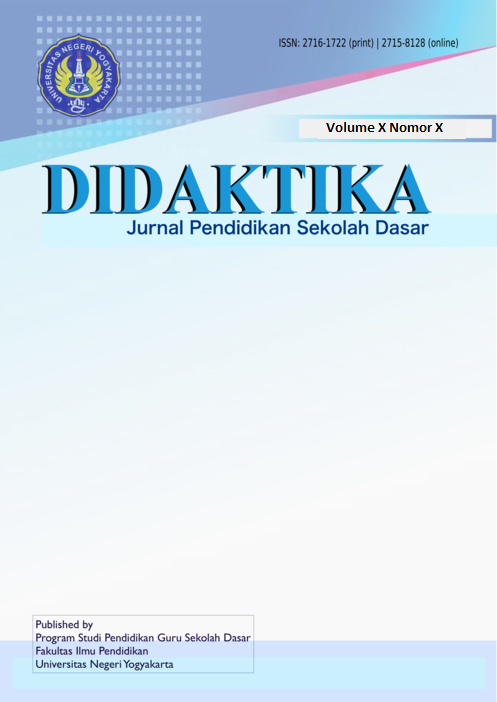Strategi Open Ended dalam Meningkatkan Kemampuan Berpikir Kreatif Siswa pada Pembelajaran Tematik
DOI:
https://doi.org/10.21831/didaktika.v3i1.29908Abstract
This study aims to determine the application of open ended strategies can improve students' creative thinking abilities. The research method used in this study is the classroom action research (CAR) method using the Kurt Lewin model consisting of four components namely, planning, action, observation and reflection. The research subjects were 45 students of MI Al-Khoiriyah Sawangan class of students. Data collection techniques used were observation sheets, interviews and documentation. Data analysis was performed in a qualitative description. Based on the results of the first cycle study 63% of students stated to have the ability to think creatively, in the second cycle 88% of students have the ability to think creatively. This achievement shows that the use of open ended strategies can improve students' creative thinking skills in thematic learning.
Keywords: Creative thinking ability, open ended, thematic learning, elementary school
References
Adelman, C. (1993). Kurt Lewin and the origins of action research. Educational Action Research, 1(1), 7–24.
Akbar, S. (2014). Penyegaran Pembelajaran Tematik Berbasis KKNI Kurikulum 2013: makalah kuliah umum. Malang: Universitas Kanjuruhan Malang.
Bernadi, R. M. A. (2017). Peningkatan kreativitas siswa kelas IV SD melalui pembelajaran tematik integratif dengan pendekatan open-ended. Jurnal Prima Edukasia, 5(1), 91–101.
Capraro, R. M., Capraro, M. M., & Morgan, Ja. R. (2013). ). STEM project-based learning: An integrated science, technology, engineering, and mathematics (STEM) approach (Second). Springer Science & Business Media.
Dumic, J., Dabelic, S., & Flí¶gel, M. (2006). Galectin-3: an open-ended story. Biochimica et Biophysica Acta (BBA)-General Subjects, 1760(4), 616–635.
Gallagher, J. J. (1991). Prospective and Practicing Secondary School Science Teachers' Knowledge and Beliefs about the Philosophy of Science. Science Education, 75(1), 121–133.
Karyana, C. (2019). Penerapan Teknik Memindai dalam Meningkatkan Kemampuan Membaca Kritis Siswa Sekolah Dasar Cikurubug. DIDAKTIKA: Jurnal Pendidikan Sekolah Dasar, 2(1), 1–8.
Mastur, M. (2017). Implementasi Kurikulum 2013 dalam pelaksanaan pembelajaran di SMP. Jurnal Inovasi Teknologi Pendidikan, 4(1), 50–64.
Mulyani, S. (2017). Metode Analisis dan Perancangan Sistem. Abdi Sistematika.
Munandar, M. (2016). Kreativitas & keberbakatan strategi mewujudkan potensi kreatif & bakat.
Prananto, I. W. (2017). Pengembangan Panduan Guru Dalam Pembelajaran Terpadu Tema Berbagai Pekerjaan Kelas IV Dengan Optimalisasi Pemanfaatan Multimedia. Universitas Negeri Semarang.
Rachmawati, Y. (2012). Strategi Pengembangan Kreativitas Pada Anak. Prenada Media.
Reja, U., Manfreda, K. L., Hlebec, V., & Vehovar, V. (2003). Open-ended vs. close-ended questions in web questionnaires. Developments in Applied Statistics, 19(1), 159–177.
Trianto, T. (2010). Model pembelajaran terpadu. Jakarta: Bumi Aksara.
Downloads
Published
How to Cite
Issue
Section
Citation Check
License
- Authors retain copyright and grant the journal right of first publication with the work simultaneously licensed under a Creative Commons Attribution License that allows others to share the work with an acknowledgement of the work's authorship and initial publication in this journal.
- Authors are able to enter into separate, additional contractual arrangements for the non-exclusive distribution of the journal's published version of the work (e.g., post it to an institutional repository or publish it in a book), with an acknowledgement of its initial publication in this journal.
- Authors are permitted and encouraged to post their work online (e.g., in institutional repositories or on their website) prior to and during the submission process, as it can lead to productive exchanges, as well as earlier and greater citation of published work.






